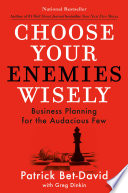

The book delves into the concept of adversaries, emphasizing that not all enemies are created equal. The author argues that choosing the right enemies can actually propel individuals and organizations toward success. Adversaries can serve as catalysts for growth, pushing us to innovate and refine our strategies. By understanding the motivations and strengths of our enemies, we can better position ourselves to counteract their influence. This idea suggests that a well-chosen adversary can provide a clear direction and purpose, driving us to achieve our goals more effectively.
Continue readingConflict is often viewed negatively, but the author presents it as a strategic tool. Engaging in conflict with the right opponents can create opportunities for improvement and differentiation. The book illustrates how strategic conflict can foster innovation by challenging the status quo. It encourages readers to embrace conflict as a means to test their ideas and strengthen their resolve. This perspective shifts the narrative around conflict from one of avoidance to one of proactive engagement, suggesting that it can lead to meaningful progress.
Continue readingCompetitors are integral to the landscape of business and personal growth. The book argues that understanding competitors' strengths and weaknesses allows individuals and organizations to carve out their unique niche. By analyzing competitors, we can identify gaps in the market and areas for improvement in our own offerings. The author emphasizes that healthy competition can drive innovation and excellence, encouraging readers to view competitors not just as threats but as valuable sources of insight and inspiration.
Continue readingFacing enemies and challenges can build resilience. The book discusses how adversity forces individuals and organizations to adapt, learn, and grow. By facing opposition, we develop a stronger character and a more robust strategy. The author shares examples of successful figures who have thrived despite facing significant adversity, illustrating that resilience is often forged in the fires of conflict. This idea encourages readers to embrace challenges as opportunities for personal and professional development.
Continue readingThe book raises important ethical questions about the choice of enemies. It explores the moral implications of engaging in conflict and the potential consequences of our choices. The author advocates for a thoughtful approach to selecting adversaries, urging readers to consider the broader impact of their actions. This idea encourages a nuanced understanding of conflict, suggesting that ethical considerations should guide our decisions in both personal and professional realms.
Continue readingPerspective plays a crucial role in how we perceive our enemies and conflicts. The book emphasizes the importance of reframing our understanding of adversaries. By shifting our perspective, we can uncover opportunities within challenges and adversities. The author encourages readers to adopt a growth mindset, viewing enemies as teachers rather than threats. This idea highlights the transformative power of perspective in navigating conflicts and achieving success.
Continue readingThe book explores the balance between collaboration and competition. While competition can drive innovation, the author argues that collaboration can lead to more sustainable success. The book discusses how aligning with certain adversaries can create mutually beneficial outcomes, fostering a culture of collaboration that enhances overall growth. This idea challenges traditional notions of competition, suggesting that strategic alliances can be formed even with former adversaries, leading to innovative solutions and shared success.
Continue reading